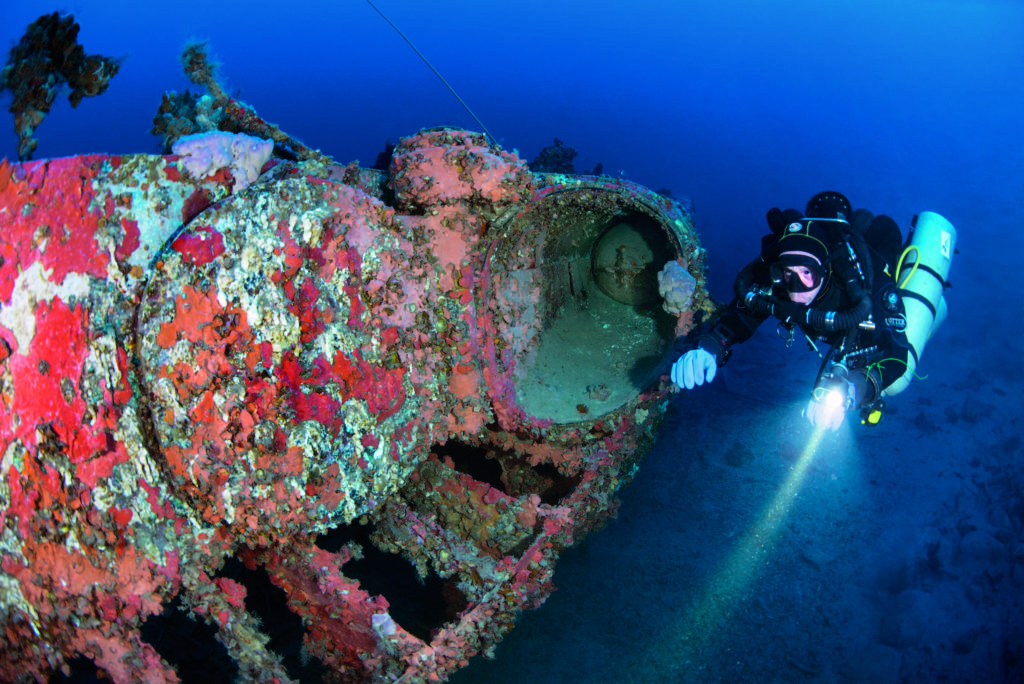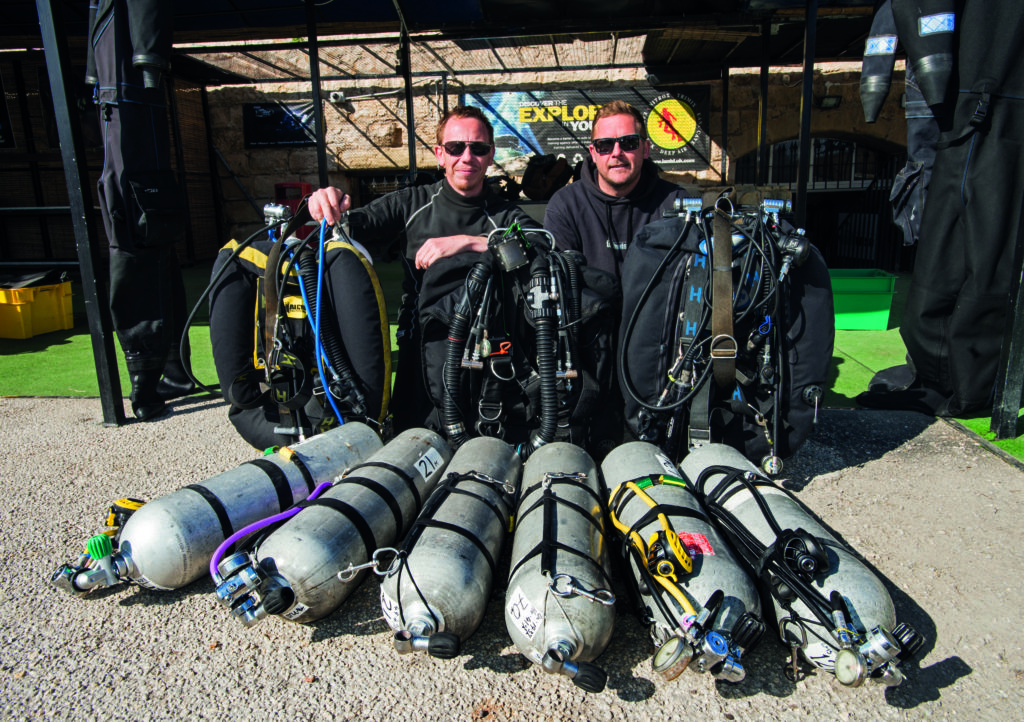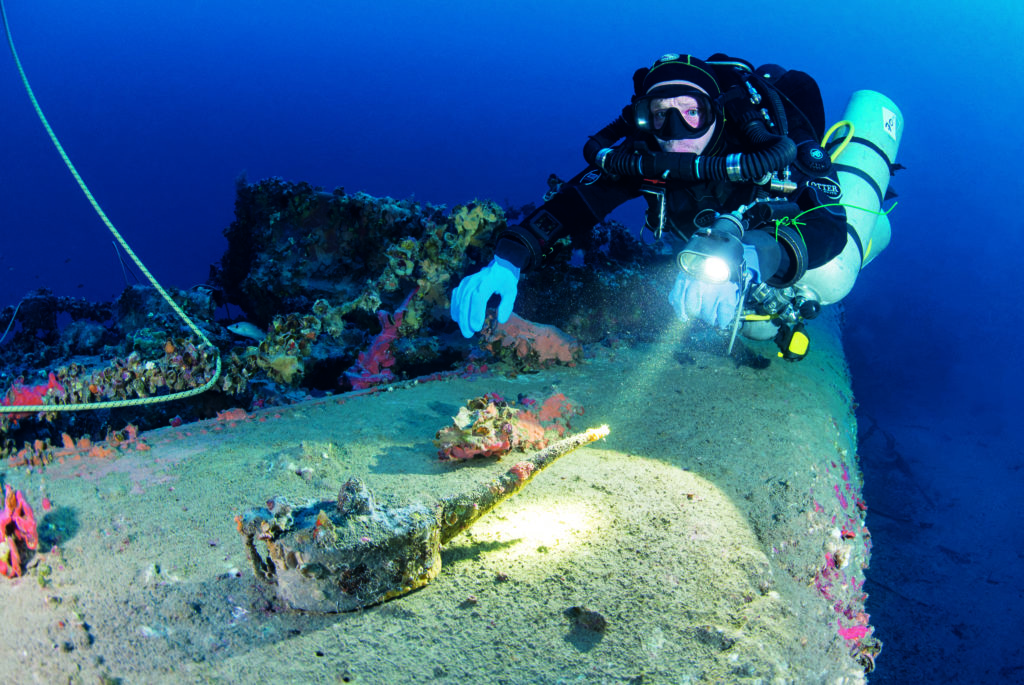Last Updated on June 13, 2024 by Divernet Team
STUART PHILPOTT enjoys a technical dive on one of Malta’s German World War Two casualties, the S-31 Schnellboot
The year before the Covid pandemic I managed to scoop an exclusive on one of Malta‘s then new list of technical-depth wrecks. Using side-scan sonar, a hand-picked team had discovered more than 100 sites, and that was with only 30% of the coastal waters surveyed.
I spoke to project leader Dr Timmy Gambin, who invited me on a 3D mapping dive of a German WW2 Junkers 88 bomber lying at a depth of around 60m.
Also read: Diver dies, 17 rescued at windy Malta shore-dive site
The plane was in surprisingly good condition considering its age, with wings, engines, tail-section, fuselage and machine-guns on display.
Back in his office on the University of Malta campus, Dr Gambin showed me video footage of other exciting finds that looked likely to make the islands even more of a must-do destination for serious tech divers.
Having experienced this awesome teaser-taster, I was keen to return and continue my tour of Malta’s new tech discoveries but, alas, politics and egos seemed to hinder the release of the first batch of 16 wreck-sites, leaving the exact co-ordinates withheld and dive-centres not authorised to visit the sites.
My flights, courtesy of Air Malta, were already booked, so I had to find some tech wreck alternatives PDQ. The Junkers 88 had been my very first German WW2 aircraft wreck, so I wondered if Malta could offer any more dive-sites with a similar pedigree.
I had already had dealings with Alan and Viv Whitehead, owners of St Julian’s-based Techwise, and was impressed with their set-up and the range of services offered. Alan suggested that if I wanted to see more German metal, the S-31 Schnellboot would probably do the job.
This wreck had originally been discovered back in September 2000, so I checked out some videos uploaded to YouTube to see what the site had to offer. The deepish maximum depth of 67m had discouraged most trophy-hunters (though not all), so there were still some interesting features left to photograph.
I was well and truly hooked. Alan arranged a dive-boat, courtesy of Jeffrey Pappalardo, and prepped the gas-mixes.
The wreck
The Schnellboot, aka E-boat, was a fast motor torpedo boat (MTB) used to attack and destroy Allied shipping during WW2. S-31 was built by Lürssen at Bremen-Vegesack in Germany and launched in 1939.
Its 33m-long hull was constructed using an aluminium framework with a mahogany wood outer skin. It had a 5m beam, and weighed approximately 100 tons.
Three Daimler-Benz 16-cylinder MB502 diesel engines delivering around 1,320bhp each gave the boat a very respectable top speed of 38 knots and an operational range of 1,500km (a derivative of the same engine was used to power the Hindenburg-class airships).
Later Schnellboot versions were fitted with MB501 20-cylinder 2,000bhp engines, which increased top speed to 44 knots. Armament included two torpedo-tubes with four torpedoes, one 20mm mounted gun and several smaller-calibre machine guns.
S-30 through to S-37 were originally bound for China, but at the outbreak of WW2 the boats were impounded and reassigned to the Kriegsmarine (German Navy). Under the command of Lt Heinrich Haag, S-31 saw plenty of action. In the North Sea, as part of 2 Flotilla, the MTB severely damaged the British destroyer HMS Kelly.
2 Flotilla moved to Ostend in August 1940 and, during an Allied raid that blew up the torpedo storage facility, four boats including S-31 were caught in the explosion. After repair work had been completed, S-31 was transferred to 3 Flotilla under the command of Friedrich Kemnade.
The white hull was repainted with a blue/grey camouflage pattern on a white background and a flying fish insignia was added. While on a mission in the Baltic Sea, S-31 and S-59 successfully attacked the Russian destroyer Storozevoj.
British forces operating from Malta were causing severe disruption to Rommel’s supply lines in North Africa, so Schnellboots S-31, S-34, S-35, S-55 and S-61 were redeployed to a base at Augusta on Sicily’s east coast and tasked with laying minefields off the Maltese coast.
Minelayer mined
On 9 May, 1942, a Luftwaffe reconnaissance plane spotted HMS Welshman heading up the Mediterranean towards Malta. The Abdiel-class minelayer was loaded with vital supplies, including ammunition, food, medicines, new Spitfire engines and ground-support crews. At 10pm seven Schnellboots were ordered to engage.
They had planned a two-pronged assault, with four boats – S-54 through to S-58 – waiting for the incoming warship up the coast, while the other three – S-31, S-34 and S-61 – laid a surprise minefield outside Valetta Harbour.
The mine-laying was completed at around 4am on 10 May, but just as they were leaving the area to rendezvous with the other four MTBs, S-31 exploded, probably after hitting a mine that had just been laid!
The blast sank the boat and killed 13 of the crew, which makes the dive-site a war grave. Normally Schnellboots carried a crew of 24 but on this operation there were 26, including two Italian military observers. Both survived, as did the commanding officer, Lt Heinrich Haag.
Malta in January
Alan Whitehead blended a trimix back-gas of 18/45 and two stage cylinders of 32 and 72% O2 for my dive. Lee Stevens and Steve Scerri got lumbered with looking after me and doubling up as my models.
Just to make my pictures more interesting, Lee had chosen to use open-circuit and Steve had fired up his JJ CCR. We planned for a 20-minute bottom-time, with just over an hour of deco stops back to the surface.
Visiting Malta in January had never really crossed my mind as presenting any problem, and most days I awoke to warm sunshine and slight seas. Water temperature hovered around 16°C, however, so I borrowed an Otter membrane drysuit from Alan’s extensive kit-store.
Visibility still averaged 20-30m and there were hardly any other divers at the sites, which made my job easier. I had packed a couple of pairs of shorts and flip-flops which, in hindsight, was probably a tad optimistic. The evenings were cooler than expected, so a few warmer tops might have been a good idea.
I had booked a room at the 5* Westin Dragonara, which couldn’t have been any closer to Techwise because they are located in the same complex. I couldn’t fault the accommodation or the facilities, and got a right pampering.
My room had a sea view and the hotel gym had more equipment than a classy David Lloyd club! There was also a choice of indoor and outdoor swimming pools, a plush bar with piano player and a lavish buffet-style breakfast ideally suited to hungry divers.
We held a pre-dive briefing to discuss the picture opportunities I had spotted in the YouTube video. Lee and Steve had visited the wreck several times before, so could advise me of any foreseeable problems.
We planned to start the dive at the bow and work our way towards the stern, taking in about six set shots. While Lee was posing for me, Steve would go ahead to the next set position and get ready – this way we wouldn’t waste any valuable time searching about.
A small wreck-site
The deep blue hues of the Mediterranean Sea made a welcome change from the UK’s emerald-green underwater tinge. I drifted onto the shotline, descended to 3m for a bubble-check and then carried on down. I caught sight of the wreck sitting upright on fine sand at about 45m.
The Schnellboot is only a small site, so a 20-minute bottom time would hopefully give me ample time to get my pictures and have a nose around. We dropped onto the bow at a maximum depth of 67m. I could see the twitching antennae of a massive lobster poking out from the skeletal aluminium framework.
The bow somehow reminded me of a great white shark’s mouth, jaws open wide. I took a few shots with Lee posing to one side, and then ascended over the bow and finned along at deck level.
Apart from a couple of tangled ropes, the site was clear of any ghost-netting, which was a relief. Steve pointed to an oil-can that had clearly been found by someone else and left in plain view on the starboard rail, but I wasn’t complaining because it made for a nice bonus composition.
The starboard-side 21in torpedo-tube had broken away and lay half-buried in the sand. The port side tube was still firmly attached and, with the rear door open, I could see the torpedo still inside. This time I got Steve to hover off to one side just to give some size perspective to my picture.
We paused to look at the armoured bridge, which had collapsed inside the hull. Lee surprised a massive grouper that instantly scarpered off into the blue.
There was considerable damage amidships, so I guess this is where the mine had exploded. I stopped by the 20mm gun-mount but, alas, there was no gun to be seen. Alan said that it had been removed and now lay in the sand, but there was no spare time to conduct a search.
We found three cases of live 20mm ammunition scattered over the deck. The wooden boxes had rotted away to leave just the shells fused together into a cube.
I fired off a few shots of Lee looking at them, and a couple more of him next to the gun-mount. I had seen a navigation lamp on the YouTube video, but could find no sign of it on the wreck. This was the only planned shot I missed.
On reaching the stern I descended a couple of metres back to the seabed. I wanted to get a shot of all three propellers, but the rudders stuck out too far and made it impossible for me to get a clean shot.
I got down as low as I could before realising that the bottom was composed of fine silt, which had already started to plume thanks to my misplaced fin-kick.
I made do with a shot of Lee looking at the starboard propeller, then moved backwards to get a wide-angle composition of the entire stern. With the mahogany outer skin completely rotted away, I could clearly see all the internal workings of the steering mechanism.
The value of research
Lee gave me the thumbs-up signal, so we made our way steadily back to the shotline and began our ascent. The 20-minute bottom had gone far too quickly.
There never seems to be any time for me to savour the atmosphere because I’m always looking through a camera viewfinder, but I felt content knowing that we had completed our plan and returned to the surface safely and on schedule.
The S-31 Schnellboot was a memorable dive, helped by the fact that I had researched the wreck’s background in advance, which always makes it come alive, and gives it more character.
Admittedly, Maltese historian Joseph-Stephen Bonanno had done all the hard work for me, having contacted Lt Heinrich Haag’s daughter.
She had given him the full story, including copies of photographs. Haag survived the war and joined the Bundesmarine in 1956, retiring as a Kapitän zur See.
I thought about the crew and what they must have gone through. I’m not sure whether all the bodies were recovered after the explosion, or if they are still lying in the wreckage somewhere, but this is worth considering.
I have heard some techies complain that the site is too small for a decent exploratory dive, but I found more than enough to keep me occupied. I even made plans for a return visit to search for the 20mm gun. My thanks to Lee, Steve, Alan and Viv from Techwise for looking after (tolerating) me.
During my meeting with Dr Gambin he had mentioned finding the remains of a Messerschmitt ME109 fighter plane, so my quest for German WW2 wrecks in Malta might well continue!
Photographs by Stuart Philpott
Also on Divernet: Eight ‘new’ deep Malta wrecks opened to diving, Heritage Malta adds three plane wrecks, The joys of wreck-diving, WW2 airman ID’d after divers find remains



